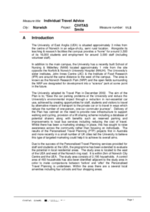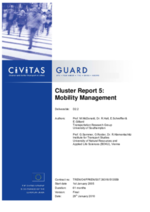Providing individual travel advice
Summary
TravelSmart personalised journey planning was introduced among students and staff at the university to encourage a modal shift in favour of public transport.
Implementing sustainable mobility
Popular and successful in Australia, the TravelSmart scheme was not widespread in the UK prior to measure implementation. Following the example of Bristol, Norwich decided to implement the journey planning concept at the University of East Anglia in order to achieve a modal shift among staff and students and to encourage 50 percent of them to opt for public transport.
The specific goals were to provide university employees and students with one-to-one travel advice and practical support, and to market sustainable travel modes among target groups living closest to the university, either on bus routes or where walking or cycling are possible options. This meant targeting a total of 8,000 people.
Progress
A personal travel advisor was appointed in August 2006 and a range of direct marketing methods were implemented to promote the measure, including targeting particular postcode areas as well as offering drop-in sessions. New members of staff were given travel-related information as part of the induction process, and students were targeted via events for freshers.
A range of publicity materials, including cycling and walking maps, were produced. Funding was also used to purchase bicycles for a “try before you buy” scheme and a bike rental scheme.
During Green Travel Week in April 2008, activities included a visit by the “Company of Cyclists - Try It” road show, the presentation of an eco-driving simulator, bike-/walk-to-work breakfasts, cycle security coding and a car sharing promotion event.
Outcomes
The measure initially delivered within the university had the following results.
- A 1 percent modal shift away from the car was achieved.
- 50 percent of the university community were travelling on foot or by bike by the end of the measure.
- There was a significant increase in shared car journeys from just under 1 percent in 2005 to 7 percent in 2008, with 240 new registrations in the lift share database during the measure.
- According to one survey, 70 percent or those who had contact with the personal travel service tried an alternative mode.
- 14 percent who received unsolicited information made changes to their travel behaviour.
- The two specific cycling schemes were very successful: 39 of the 48 people who participated in the “try-before-you-buy” scheme went on to buy a bike and started cycling two to three times each week.
- 122 people changed their travel behaviour outside their commute, demonstrating greater awareness of the reasons for change.
- Only 4 percent of those surveyed rated the service as of little or no value.










